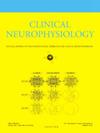Enhanced cortical facilitation after intermittent theta burst stimulation with increased stimulation intensity
IF 3.6
3区 医学
Q1 CLINICAL NEUROLOGY
引用次数: 0
Abstract
Objective
Intermittent theta burst stimulation (iTBS) can modulate the neuronal activity in the primary motor cortex. However, the responsiveness to the protocol shows high inter-individual variability which remains not fully understood. This study investigated whether responsiveness to iTBS depends on stimulation intensity.
Methods
We conducted a sham-controlled, single-blinded experiment. Sixteen healthy volunteers participated in three sessions: iTBS at 80% of the active motor threshold (80%AMT), iTBS at 80% of the resting motor threshold (80%RMT), and a sham iTBS. Stimulation was applied to the hand representation of the primary motor cortex. The aftereffects of iTBS were assessed by changes in the amplitude of motor evoked potentials (MEPs) measured in posterior-anterior (PA) and anterior-posterior (AP) coil orientations to understand if there is differential effect in cortical networks.
Results
Our results showed significant facilitation of both PA and AP MEPs following iTBS at 80%RMT but not after iTBS at 80%AMT or sham stimulation. Additionally, the number of responders was greater following iTBS at 80%RMT compared to iTBS at 80%AMT.
Conclusions
Our results suggest that higher intensity iTBS may more effectively increase cortical excitability.
Significance
This finding has the potential to improve the efficacy of various iTBS applications and facilitate their clinical application.
随着刺激强度的增加,间歇性θ波爆发刺激后皮层易化性增强。
目的:间歇θ波爆发刺激(iTBS)可调节初级运动皮层的神经元活动。然而,对方案的响应性显示出高度的个体间变异性,这仍未完全了解。本研究探讨iTBS的反应性是否取决于刺激强度。方法:采用假对照、单盲实验。16名健康志愿者参加了三个阶段:在80%的活动运动阈值下进行iTBS (80% amt),在80%的静息运动阈值下进行iTBS (80% rmt),以及假iTBS。刺激应用于初级运动皮层的手部表征。iTBS的后遗症是通过测量后-前(PA)和前后-后(AP)线圈取向的运动诱发电位(MEPs)振幅的变化来评估的,以了解皮层网络是否存在差异效应。结果:我们的研究结果显示,在80%RMT的iTBS后,PA和AP的MEPs都有显著的促进作用,而在80%AMT或假刺激的iTBS后,PA和AP MEPs没有显著的促进作用。此外,80%RMT时的iTBS应答者数量比80%AMT时的iTBS应答者数量更多。结论:我们的研究结果表明,高强度iTBS可能更有效地增加皮质兴奋性。意义:这一发现有可能提高各种iTBS应用的疗效,促进其临床应用。
本文章由计算机程序翻译,如有差异,请以英文原文为准。
求助全文
约1分钟内获得全文
求助全文
来源期刊

Clinical Neurophysiology
医学-临床神经学
CiteScore
8.70
自引率
6.40%
发文量
932
审稿时长
59 days
期刊介绍:
As of January 1999, The journal Electroencephalography and Clinical Neurophysiology, and its two sections Electromyography and Motor Control and Evoked Potentials have amalgamated to become this journal - Clinical Neurophysiology.
Clinical Neurophysiology is the official journal of the International Federation of Clinical Neurophysiology, the Brazilian Society of Clinical Neurophysiology, the Czech Society of Clinical Neurophysiology, the Italian Clinical Neurophysiology Society and the International Society of Intraoperative Neurophysiology.The journal is dedicated to fostering research and disseminating information on all aspects of both normal and abnormal functioning of the nervous system. The key aim of the publication is to disseminate scholarly reports on the pathophysiology underlying diseases of the central and peripheral nervous system of human patients. Clinical trials that use neurophysiological measures to document change are encouraged, as are manuscripts reporting data on integrated neuroimaging of central nervous function including, but not limited to, functional MRI, MEG, EEG, PET and other neuroimaging modalities.
 求助内容:
求助内容: 应助结果提醒方式:
应助结果提醒方式:


